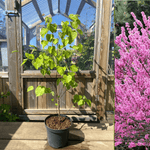Subscribe and save 10%!

Eastern Redbud / Judas Tree 70-100 cm (Cercis canadensis)
540 SEK
Unit price perExpected delivery date: 20 December to 27 December.
Applies to orders within Sweden. For other countries - see our delivery terms .
In stock - Ready to be shipped
Share
540 SEK
Unit price perEastern Redbud tree: 2 years old - current height 70-100 cm
Common Names: Eastern Redbud, American/Canadian Judas Tree, Mexican/Texas Redbud
Scientific name: Cercis canadensis
Family: Fabaceae
Plant history & use:
This variety of Judas Tree originates from North America. When the American Judas Tree was discovered by the Spanish in the second half of the 16th century, it was compared to the Judas Tree from the Mediterranean region (Cercis siliquastrum) which they already knew - it is also the tree we most commonly refer to when we say Judas Tree here in the European region. The main differences are that the American Judas Tree has pointed leaves and is slightly smaller in adult size and is more cold hardy - compare C. canadensis ' USDA zones 4-9 with C. siliquastrum's USDA zones 6-10. C. canadensis should also be more suited to moist environments/soils than many other species in the genus.
Blooms in March-April with bright pink flowers on the bare trunk, then also on the main trunk of the tree, which is often very eye-catching. Flowering is said to be strongly controlled by the extent of the previous winter. After harsh winters the Judas Tree blooms more profusely, after milder winters less so.
The flowers can be eaten raw or pickled. They have a refreshing sour taste and are rich in vitamin C. Exciting addition to a salad.
Unopened flower buds can also be pickled or put in like Capers.
Native American tribes in North America covered the ripe seed pods with glowing coals, then peeled and ate the roasted seeds. I assume a modern way to do this is to simply separate the seeds from the pod and roast the seeds over the stove or in the oven to make them ready to eat. Some sources claim to have soaked and boiled the seeds like lentils, which are also a pea plant.
The fruits are rich in protein like other plants in the pea family (Fabaceae). Dry seeds contain about 25% protein, 8% fat and 3% minerals of various kinds. To be an unrefined (and wild in North America) source of nutrition this is quite good, nutritionally it competes with both Pecan and Walnut. The seed pods remain on the tree for a long time - they are available from late summer right through to winter - and are considered acceptable for consumption during this period. However, the seed pods can sometimes be found remaining until the spring of the following year, whether they are fit for consumption then or not is not stated. For the aforementioned reasons, the seeds of C. canadensis are considered a useful source of survival food.
The young, green and brittle seed pods can be eaten like sugar snap peas - steam them, boil them or stir-fry them. They fit well in a wok with, for example, onions, garlic, paprika and leafy vegetables. The leaves can be eaten as well - younger, brittle leaves are recommended.
Tea made from the inner bark has been used to reduce fever etc. Cold brewing of roots and inner bark has been used in old folk medicine to treat whooping cough.
Diligent in attracting pollinators with its profuse flowering. Considered a good tree for honey bees.
The tree also has many other applications within North American Indian culture. A story about Judas and how he gave the tree its international name is easy to find for those interested in reading.
Cultivation:
Even though the American Judas Tree is considered better suited to moist soils than other species in the genus, it prefers not to grow in excessively wet soils with a high clay content. It thrives best in slightly sandier clay soils.
Likes to grow in a sunny position, also does well in light shade.
The American Judas tree is a fast-growing tree that often lives up to 80 years old.
Flowers appear in March-April on the previous year's growth.
The American Judas tree is one of the few species in the pea family that does not fix nitrogen via its roots from air pores in the soil.
Characteristics:
Age: Perennial
Location: sun / light shade
Height: 6-10 m
USDA zone: 4-9
- Choosing a selection results in a full page refresh.
- Opens in a new window.













